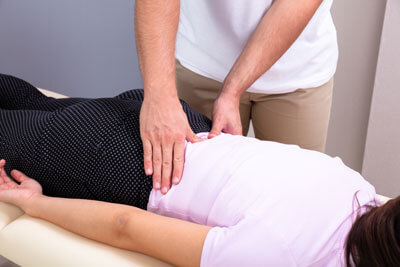Pain Neutralization Technique (PNT) in Montville
 Gentle Tissue Manipulation
Gentle Tissue Manipulation
Pain Neutralization Technique is a non-pharmacological, non-invasive technique for pain neutralization developed by Dr. Steven Kaufman, DC, LAc. The technique involves gentle tissue manipulation to “turn off” the nerve-based reflexes that perpetuate trigger points and muscle pain, and is proving to be particularly effective in the treatment of chronic pain.
The technique is based on the Clasp Knife Reflex (also called Golgi Tendon Organ Reflex), which is a defensive action protecting our muscles from injury. PNT gently uses a specific stimulation, accurate positioning, and light pressure by hand to activate the clasp knife reflex. The stimulated muscle relaxes and tenderness of the trigger point is relieved. This can resolve long term symptoms that were exacerbated by that trigger point.
What are Trigger Points?
Trigger points are tiny knots that develop in a muscle when it is overworked or injured. The knots are tight bands of muscle or contraction knots in the muscle tissue. They often feel like nodules and are painful when pressed.
PNT can be therapeutic for these conditions, and more:
- Neck pain
- Low back pain
- Headache
- Migraine
- Jaw pain (TMJ)
- Post surgical & non pathological abdominal pain
- Frozen shoulder
- Sciatica
- Ileotibial band syndrome
- Cervical and lumbar disc syndrome
- Tennis elbow
Testimonials
A 45-year-old retired Army Ranger was seen because of back pain. His list of past physical trauma and injury was extensive, even impressive. From multiple concussions to broken ankles, and nearly every segment of his body in between, the injuries were primarily acquired during Ranger training and deployment.
At his first visit, this Ranger self-scored his mid-back pain at seven to ten (depending on where in his back) out of ten. He could only face his head and body in one direction at a time, as his pain would increase dramatically if he turned his head or back separately in either direction.
When he was face down on the treatment table, the muscles along the right side of his spine were actually two inches higher than those on the left. (Dr. Werblud and most other Tahoma Clinic physicians have never seen that before.) After the first PNT session, the muscle groups were even on the right and left, and he scored his pain level at three out of ten for the first time in many years.
He was skeptical that the pain relief would last because the treatment was so gentle. But at the time this is written, he’s had three more treatment sessions to address other pain issues. He’s reported that back pain has been no higher than a five of ten at any time since his first treatment.
A 15-year-old high school competitive swimmer had been injured in a car-to-bicycle collision. He was struck by the car and thrown over it the hood, landing on pavement hands-first. His right wrist was broken, requiring hand-to-shoulder casting. His orthopedic physician thinks his right shoulder became inflamed and strained during the extensive immobilization.
He was not able to move his right shoulder without pain, around the shoulder joint, itself and the right side of his upper back. His scored his pain from three to nine out of ten, depending on his activity level. The front of his right shoulder was exquisitely painful to touch and approximately 10% larger than his left shoulder. The muscles on right side of his spine from the base of the neck and down ten inches (from the first to the seventh thoracic vertebrae) were tight and swollen.
When he lay face down, the right side of his back looked like a mound. It varied from one to two inches higher than the left side, was very sensitive to touch and very tight. After his first treatment, the “mound” in the muscles to the right of his spine was lowered to ¼ inch above the left, and he scored his pain at one of ten. At the time this was written, he’d had four total PNT sessions. He reports having lower pain levels generally.
At his first visit, he was not happy that yet another doctor would be poking and prodding at his shoulder, which had so far just produced more pain. After that first visit, he has been happy to return because he gets immediate relief and his experience was an overall improvement in his pain levels and his swim times and finds the treatment relaxing. He actually slept through the last two treatments!
Get Started Today
Contact Montville Chiropractic today to schedule an appointment.
CONTACT US »

